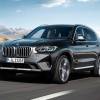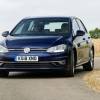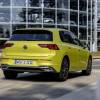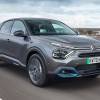
Complete peace of mind for less
• £50 off a mobile car service†
• We get to most breakdowns in 60 mins or less
• Our patrols fix 4/5 on the spot
* At least 10% of new customers paid this or less since 12/08. †Applies to new Extra or Complete cover. Restrictions apply, check mobile mechanic eligibility & availability here. Ends 18/11, 4pm.

Volkswagen has big aspirations with this all-electric luxury ID.7. Jonathan Crouch takes a look.
Ten Second Review
The ID.7 is Volkswagen's most sophisticated and luxurious full-electric ID model yet. It showcases a different level of drive and battery technology to anything previously seen from the brand. And manages to do so with a polished presentation that for some will make this smart Fastback-style five-door a really credible alternative to similarly-sized offerings from the premium makers.
Background
In the combustion era, Volkswagen's brand equity couldn't quite be stretched far enough to sell large luxury saloons. As a company found with the ill-fated Phaeton, produced between 2003 and 2014. But might this new EV era be different? A time when customers are supposed to be more interested in battery technology than badge work. We're going to find out because here in the ID.7, we have one of the most upwardly premium-orientated Volkswagen models to be launched in a decade. And a flagship for the company's fast-growing ID all-electric range.
This, if you like, is beginning of a second wave of ID models, learning from the design lessons of the ID.3, the ID.4 and the ID.5 and incorporating more of the cabin sustainability from the ID.Buzz. Not all of these are sold worldwide, but the ID.7 will be, sized and shaped similarly to the combustion Arteon Fastback five-door model, which aimed to be the next step up for Passat people, but never quite was. Volkswagen is confident that the ID.7 will be and to that end has gone to town on technology here. Not least with the brand's biggest, fastest-charging, longest-range battery to date. Sounds promising. Let's take a closer look.
Driving Experience
There's lots of fresh drive technology here, principally with the new 210kW e-motor. This differs from previous VW Group EV motors, with stronger magnets, a higher wire cross-section, more windings and improved cooling, all of which ought to improve efficiency and power (rated at 282hp). All initial ID.7s will be of the single motor rear-driven sort: a dual motor AWD GTX performance version will follow. This will pair the 282hp rear motor with a 107hp front motor, for a combined output of around 390hp. You'll want to know about drive range on the mainstream models. The familiar 77kWh 'Pro' battery offered from launch will take the car up to 382 miles. A larger 'Pro S' battery (at 86kWh the VW Group's biggest to date) will arrive later to improve that to 434 miles.
You twist the gear selector (now a column-mounted stalk) to get going, one notch for 'Drive' and two notches for the 'B' mode that maximises regenerative braking and allows for near one-pedal driving. On the move, there are four main drive mode options - 'Eco', 'Comfort', 'Sport' and 'Individual'. And if you've ticked for the option of Adaptive Chassis Control adaptive damping, these will control ride quality too. Expect exemplary refinement thanks to the slippery aerodynamics. As you'd expect, there's plenty of autonomous drive tech. Volkswagen's now familiar 'Travel Assist' set-up has been updated with an 'Assisted Lane Change' feature. And it uses 'swarm data' from other VW Group vehicles for more accurate speed control and lane guidance.
Design and Build
After its experience with the Phaeton. Volkswagen seems reluctant to create another super-sized saloon, so like its combustion counterpart the Arteon, this ID.7 adopts a Fastback five-door body shape. But a much more slippery one, the sloping black roof, the raked windscreen, the short overhangs and the floating flush pillars delivering a super-sleek 0.23Cd drag coefficient. There's 4,961mm of length, with 1,538mm of roof height which, to give you some perspective, makes it 186mm longer and 55mm higher than a Passat. The front continues with the familiar ID series look, a stubby bonnet flowing into flush headlamps fitted out with IQ.Light tech. The rear is more of an ID styling departure, with a full-width light bar that appears white until illuminated.
Much has been learnt by the VW designers in creating the cabin. For a start, it feels of much higher quality than any ID model to date, with plush materials and plenty of soft-touch surfaces. The other thing you'll notice is that there's no big instrument screen (or smaller instrument screen pod as in other ID models). Instead, most of what you need to know is projected via the standard Head-up display, incorporating augmented reality tech. A small, minimalist instrument screen is retained in the line of the cabin's innovative 'Smart Air Vents' which (annoyingly) can only be angled via the central touchscreen, or by the now improved 'IDA' voice control system.
On that subject, media tech is much improved over earlier ID models, with a completely re-designed 15- inch central infotainment touchscreen featuring permanently-displaying climate controls. There's a new direct access bar at the top of the touchscreen for quick access to frequently used functions; and the home screen can be customised with icons for commonly used apps. Plus the lower slide bar for volume and temperature has (at last) been back-lit so you can use it properly at night. Out back, thanks to the lengthy 2,966mm wheelbase (180mm longer than a Passat), there's generous space for two adults. And you get an enormous 532-litre boot.
Market and Model
Price-wise, we can expect the ID.7 to slot in just above the ID.5, which would mean a likely price span of between £55,000 and £70,000. Lots of technology can be included to justify these kinds of figures. Like the electronically dimmable panoramic sunroof with smart glass which can be switched between opaque and transparent settings by touch control. Like many other functions in the ID.7, the roof can also be operated by means of natural voice commands - this takes place using the 15-inch central screen's built-in 'IDA' voice assistant. The optional 'Climatronic' front seats can offer cooling or heating as required and also a drying function, plus a massage system with a seal of approval from the German Campaign for Healthier Backs (AGR) is also available.
The range of options is rounded off by a 700-watt sound system from Harman Kardon with 14 high-end loudspeakers, including a centre speaker at the front and a subwoofer in the luggage compartment. When it comes to parking, the electric Volkswagen can independently perform assisted manoeuvres in different ways. One of these is parking with memory function over a distance of up to 50 metres. For this, the driver either remains sitting in the ID.7 or monitors the parking procedure from outside the vehicle using the smartphone app.
Cost of Ownership
You might hope that the ID.7 would use the advanced 800V electrical infrastructure that allows another only slightly larger VW Group model, the Audi e-tron GT quattro, to use the new generation of ultra-fast public chargers. Because the ID.7 uses a different platform to that Audi - merely a stretched version of the MEB chassis primarily developed for much smaller, more affordable EVs, only a 400V system is in play here. But Volkswagen has done its best to maximise possible charging speeds from it: the ID.7 can charge at up to 170kW in 77kWh 'Pro' form (with a 382 mile range); and up to 200kW in 86kWh 'Pro S' guise (with a 435 mile range). This is also the first Volkswagen model to get battery pre-conditioning, which, once a charger destination is programmed into the navigation, readies the battery for maximum top speed charging capability on arrival. You can trigger that feature manually too.
Volkswagen has done its best to help by providing its EV owners with a 'We Charge' app that helps you find and use over 150,000 public charge points. Expect a 10-80% top-up in the 77kWh model to take under half an hour from a public rapid charger. On the move, a standard 'Eco Assistance' feature draws on navigation data and road signs detected by the car's forward-facing camera so that if your ID.7 is approaching a bend or a town boundary, the system can visually indicate that you should lift off the accelerator. This apparently simple, yet complex calculation allows the car's drive system to perform optimum energy recuperation, thereby supporting optimum range performance.
An ID.7 driver will enjoy lower maintenance costs than would be needed for a combustion model - obviously no oil changes are required and regenerative braking means that the brake pads are designed to last the life of the car. There's a fixed servicing schedule, with a basic inspection after two years (unlimited mileage) and subsequent services every year or 20,000 miles. There's the usual unremarkable three year / 60,000 mile Volkswagen warranty (the third year operated by the retailer).
Summary
The VW Group's all-electric MEB platform wasn't really developed for luxury cars. But on this evidence, it does a pretty good job in underpinning one. Basically, what's on offer here is just about everything you get from a Mercedes EQE for an awful lot less. The ID.7 will significantly under-cut closer market players like the BMW i5 and the Audi A6 e-tron too.
But then, the combustion-powered Volkswagen Arteon significantly under-cuts similarly sized rivals from Mercedes, BMW and Audi on price too, yet that's a rare sight, even in its home market. Will the ID.7 fare better? We think so. It's a more polished, premium-feeling package being sold to an EV segment that's become far less badge-conscious. You might not be blown away by the looks and we're unconvinced about the cabin's trumpeted 'Smart Air Vent' tech, but overall, this is a big step forward from the engineering seen in Volkswagen's first EV global player, the ID.4. The '7' is a fitting ID flagship. And a sign to rivals that the VW Group's EV technology is really getting into its stride.




![Volkswagen Polo [9N] (2005 - 2009) used car review](https://d1ix0byejyn2u7.cloudfront.net/drive/images/made/drive/images/remote/https_d2yv47kjv2gmpz.cloudfront.net/filestore/6/9/3_8f0eb645d8f1d4f/1aea23d8053e30e0af8ba9879af5c2b2/396_f49ce502ca91012_100_100_70_c1_c_c.jpg)


